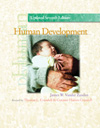 |  Human Development: Updated, 7/e James Vander Zanden,
Ohio State University
Thomas Crandell,
Broome Community College
Corinne Crandell,
Broome Community College
Adolescence: Emotional and Social Development
Chapter OutlineChapter 12 discusses the stage of adolescence in the context of society's need to facilitate young people's quest for autonomy and a positive self-identity. Several significant issues are explored, including the following:
1Development of Identity. Several theories of adolescent emotional and social development are introduced, including those of Hall, Sullivan, Erikson, Bandura, and Gilligan. |
 |  |  | 2Peers and Family. The unique developmental role of the adolescent peer group is discussed, as well as the importance of adolescents' relationships with their families. |
 |  |  | 3Teenage Courtship, Love, and Sexuality. The difficult adjustment by young people in regard to their experiences with dating, love, and sexuality is examined. The typical patterns and functions of dating are presented; the indefinable notion of love, as well as a possible physiological basis for this romantic attraction, is discussed. The chapter reviews the dynamic state of adolescent sexual expression, recent changes in sexual behavior, and (within this context) problems associated with teenage pregnancy. |
 |  |  | 4Vocational Choices. The importance of adolescent decisions regarding vocational options is presented, as well as the issue of working teens. Special attention is given to the topic of whether or not teenagers should work. |
 |  |  | 5Risky Behaviors. Other important issues relevant to teenagers are examined, such as drug abuse, teenage suicide, antisocial behavior, juvenile delinquency, and high school attrition. Special emphasis is given to suicide warning signals among adolescents. |
|



 2003 McGraw-Hill Higher Education
2003 McGraw-Hill Higher Education